#DefenseTechnology
Explore tagged Tumblr posts
Text
The World’s First Stealth Fighter Jet 😮😆
#desiviralrecap#StealthFighter#StealthJet#AviationHistory#MilitaryTech#FighterJet#AviationLovers#AerospaceEngineering#AirForce#MilitaryAviation#JetFighter#AviationDaily#TechInnovation#TopGun#AviationPhotography#WarPlanes#NextGenAircraft#DefenseTechnology#AviationEnthusiast#StealthTechnology#AviationGeeks
1 note
·
View note
Text
AI on the Battlefield | Future of War or Ethical Nightmare? With Thomas Ellsworth (S2 Ep-6) | iShook
youtube
Dive into the depths of a provocative debate on "AI in Warfare: A Revolution or a Risk?" with Beni Rachmanov and the analytics guru, Tom Ellsworth. As they unravel the layers of AI's integration into military strategies, this discussion sheds light on the dramatic shifts and potential hazards this technological evolution brings to global defense mechanisms. From ethical dilemmas to groundbreaking advancements, immerse yourself in a conversation that navigates the intricate balance between innovation and morality in the modern battlefield. Whether you're a tech enthusiast, a military analyst, or simply curious about the future of warfare, this video promises insights that will fuel your passions and provoke thought.
#aiinwarfare#militarytechnology#benirachmanov#tomellsworth#futureofwarfare#ethicalai#defensetechnology#artificialintelligence#modernbattlefield#warandtech#aistrategy#technologyandmorality#militaryethics#aiinnovation#ishookdiscussion#Youtube
0 notes
Text
SOSA Aligned | SOSA Systems
Elma’s SOSA and CMOSS Aligned 12-Slot 3U Development Platform served as the heart of joint efforts by five SOSA Consortium member companies to build and test a fully functioning system aligned to SOSA. These industry partners, that participated in the demo using Elma’s development platforms included Behlman Power, Concurrent Technologies, Crossfield Technology, Curtiss Wright, Interface Concept and Spectranetix (a Pacific Defense company).

#SOSA#SOSAAligned#SOSAStandard#SOSAReady#SOSACompliant#SOSAPlatform#SOSAConsortium#OpenArchitecture#ModularOpenSystems#SOSAIntegration#ElmaSOSA#ElmaOpenVPX#ElmaDefenseSolutions#ElmaMissionSystems#ElmaRuggedPlatforms#ElmaBackplanes#ElmaModularDesign#SOSAByElma#DefenseTechnology#AerospaceComputing#RuggedEmbeddedComputing#TacticalSystems#CMOSS#VPXSystems
0 notes
Text
Structural Composites Market: Transforming Aerospace, Automotive & Energy Sectors

The structural composites market has witnessed significant growth in recent years, driven by advancements in material science and increasing demand across multiple industries, including aerospace, automotive, construction, and wind energy. Structural composites, often referred to as composite materials, are made by combining two or more materials that are superior in performance than individual components. These materials are lightweight, durable, corrosion-resistant, and provide enhanced mechanical strength, making them ideal for a wide range of applications.
Get a Free Sample Report - https://www.skyquestt.com/sample-request/structural-composites-market
The global structural composites market is expected to continue its growth trajectory, driven by technological innovations, increased awareness of environmental sustainability, and the rising demand for lightweight, high-performance materials. By 2032, the market is poised to expand significantly, with substantial contributions from key sectors, including aerospace and defense, automotive, and wind energy.
Market Size and Forecast
The global structural composites market was valued at USD 50.43 billion in 2024 and is projected to reach USD 94.81 billion by 2032, growing at a compound annual growth rate (CAGR) of 7.54% during the forecast period from 2025 to 2032.
Several factors contribute to the market's growth, including the increasing demand for lightweight materials, the rising need for energy-efficient solutions, and advancements in composite manufacturing technologies. Composites are particularly attractive for industries where strength-to-weight ratios are critical, such as in aerospace and automotive applications.
Key Market Segments
1. By Resin Type:
- Epoxy Resin: Epoxy resins are the most widely used in structural composites due to their superior mechanical properties, resistance to moisture, and excellent bonding capabilities.
- Polyester Resin: Used predominantly in automotive and construction applications, polyester resins are a more cost-effective option.
- Vinyl Ester Resin: Offering a balance between performance and cost, vinyl ester resins are used in applications like marine and automotive industries.
2. By Fiber Type:
- Carbon Fiber: Known for its high strength-to-weight ratio, carbon fiber composites are extensively used in aerospace, automotive, and sports equipment.
- Glass Fiber: Glass fibers are the most commonly used fibers in structural composites. They are cost-effective and widely used in construction, marine, and transportation sectors.
- Aramid Fiber: Aramid fiber composites offer high impact resistance and are used in applications that require ballistic protection, such as in defense and automotive sectors.
3. By Application:
- Aerospace & Defense: The aerospace industry remains a dominant sector for structural composites due to the material’s lightweight and high-strength properties. Aircraft manufacturers are increasingly adopting composites to reduce fuel consumption and improve efficiency.
- Automotive: Lightweight composite materials are essential for the automotive sector to improve fuel efficiency and reduce carbon emissions. With growing demands for electric vehicles (EVs), the automotive industry is turning to composites for body parts, interiors, and under-the-hood components.
- Wind Energy: Wind turbine blades are commonly made from composite materials, as they provide the necessary durability and strength while reducing the overall weight of the turbines.
- Construction: Structural composites are finding increasing applications in the construction sector, particularly in bridges, beams, and support structures, where strength and corrosion resistance are paramount.
- Marine: Composites are used in boat and ship construction due to their resistance to corrosion, weight reduction, and durability.
Make an Inquiry to Address your Specific Business Needs - https://www.skyquestt.com/speak-with-analyst/structural-composites-market
Regional Market Analysis
1. North America: North America is one of the largest markets for structural composites, driven by the aerospace and automotive industries in the U.S. and Canada. The region is home to major aerospace manufacturers such as Boeing and Lockheed Martin, which are heavily investing in composite materials for aircraft manufacturing. Additionally, the push for fuel-efficient vehicles in the automotive sector continues to bolster the demand for lightweight materials.
2. Europe: Europe is another key market for structural composites, with strong demand coming from the automotive and wind energy sectors. The region's commitment to reducing carbon emissions and improving energy efficiency is a key driver of market growth. Leading countries like Germany, France, and the U.K. have seen significant investment in renewable energy infrastructure, including wind farms that rely on composite materials for turbine blades.
3. Asia-Pacific: The Asia-Pacific region is expected to experience the fastest growth in the structural composites market. The expanding automotive and construction industries in countries like China, Japan, and India are major factors contributing to the region's rapid market expansion. Moreover, the increasing investments in renewable energy and the aerospace sector in countries like China are fueling demand for structural composites.
4. Latin America and Middle East & Africa: The Latin American market for structural composites is gradually growing due to the construction and automotive sectors' increasing adoption of lightweight materials. Similarly, the Middle East and Africa region is showing promising growth, particularly in the aerospace and defense sectors, where composites are used for aircraft components.
Key Market Drivers
1. Increasing Demand for Lightweight Materials: One of the primary drivers of the structural composites market is the increasing demand for lightweight materials. Industries such as aerospace, automotive, and wind energy are seeking to reduce the weight of their products to improve fuel efficiency, reduce carbon emissions, and increase overall performance.
2. Advancements in Composite Manufacturing: Technological advancements in composite manufacturing techniques, such as automated fiber placement (AFP) and resin transfer molding (RTM), are making it easier and more cost-effective to produce high-quality composites. These advancements have made composites more accessible to a wide range of industries.
3. Environmental Sustainability: The growing emphasis on sustainability and environmental responsibility is driving the adoption of composite materials. Composites can help reduce fuel consumption and energy use in transportation, which aligns with global sustainability goals. Additionally, the longer lifespan and recyclability of certain composite materials make them attractive for companies seeking to minimize their environmental impact.
4. Growth in Aerospace and Automotive Sectors: The aerospace and automotive industries continue to be significant consumers of structural composites, with major companies like Boeing, Airbus, and Tesla adopting advanced composites in their products. The shift toward electric vehicles (EVs) is expected to further boost the demand for lightweight composite materials.
Take Action Now: Secure Your Structural Composites Market Today - https://www.skyquestt.com/buy-now/structural-composites-market
Challenges
Despite the significant growth prospects, the structural composites market faces several challenges, including:
- High Production Costs: The cost of producing composite materials, especially carbon fiber, remains high, which can limit their widespread adoption in cost-sensitive industries.
- Complex Manufacturing Processes: The manufacturing of structural composites requires specialized equipment and expertise, which can make it difficult for small and medium-sized enterprises to enter the market.
- Recycling Issues: While certain composites are recyclable, the recycling of composite materials remains a challenge, particularly for thermoset composites.
Top Players in Structural Composites Market
Owens Corning (USA)
Toray Industries, Inc. (Japan)
Teijin Limited (Japan)
Mitsubishi Chemical Holdings Corporation (Japan)
Hexcel Corporation (USA)
SGL Carbon (Germany)
Huntsman International LLC. (USA)
Solvay (Belgium)
Gurit Holding AG (Switzerland)
BASF SE (Germany)
3M (USA)
Hexion Inc. (USA)
Johns Manville (USA)
Saint-Gobain (France)
Kordsa (Turkey)
Lanxess AG (Germany)
China Jushi Co., Ltd. (China)
Avient Corporation (USA)
Borealis AG (Austria)
Celanese Corporation (USA)
Read Structural Composites Market Report Today - https://www.skyquestt.com/report/structural-composites-market
The global structural composites market is poised for significant growth through 2032, driven by increasing demand for lightweight, high-performance materials across industries such as aerospace, automotive, and wind energy. The continued advancement in manufacturing technologies and a growing focus on sustainability will play key roles in shaping the market's future. However, challenges related to production costs, manufacturing complexity, and recycling must be addressed to unlock the full potential of structural composites in the coming years. With ongoing research and development, the market is expected to witness the emergence of innovative solutions that will further expand the scope of composites in various industries.
#StructuralComposites#CompositeMaterials#MaterialsScience#AdvancedMaterials#CompositesMarket#SmartMaterials#GlobalMarketTrends#EngineeringMaterials#HighPerformanceMaterials#LightweightMaterials#AerospaceEngineering#AutomotiveInnovation#WindEnergy#SustainableConstruction#GreenEnergy#MarineEngineering#ElectricVehicles#EVMaterials#DefenseTechnology#InfrastructureInnovation
0 notes
Text
Unmanned Surface Vehicles (USVs) Market Trends Shaping Naval Operations, Research, and Commercial Growth
The unmanned surface vehicles (USVs) market trends are evolving rapidly, driven by increasing demand across military, commercial, and scientific sectors. As maritime operations seek greater automation and efficiency, USVs are gaining prominence for their ability to conduct missions without risking human lives. Their growing role in naval defense, oceanography, environmental monitoring, and offshore energy operations is reshaping marine capabilities worldwide.

One of the primary factors driving growth in the USVs market is the surge in defense applications. Nations are increasingly incorporating USVs for tasks such as surveillance, reconnaissance, mine countermeasures, and anti-submarine warfare. These vehicles offer real-time intelligence gathering with minimal human involvement, making them highly efficient tools for naval forces. With geopolitical tensions escalating in various regions, investment in maritime defense technology has grown significantly. This rise in military spending is directly impacting the demand for advanced USV platforms equipped with sophisticated sensors, communication systems, and autonomous navigation capabilities.
Beyond defense, the commercial sector is adopting USVs for applications such as offshore oil and gas exploration, pipeline inspection, and underwater surveying. Energy companies are leveraging USVs to improve safety and reduce costs by minimizing the need for manned missions in hazardous environments. Their utility in long-duration missions and harsh sea conditions makes them ideal for continuous monitoring and data collection. In addition, increased interest in renewable offshore energy sources, particularly wind farms, is expanding the market potential for USVs in infrastructure inspection and maintenance.
Scientific research and environmental monitoring also represent key segments contributing to the market’s momentum. USVs are being used to study marine biodiversity, track ocean currents, and monitor climate change indicators. Organizations involved in oceanography and environmental science prefer USVs for their ability to cover vast areas over long periods, collecting high-quality data without disrupting marine ecosystems. These capabilities align with global initiatives to better understand and preserve ocean health.
Technology is at the heart of these market developments. Modern USVs are equipped with cutting-edge autonomy features such as collision avoidance, adaptive route planning, and machine learning-based decision-making. Improvements in battery life, energy efficiency, and propulsion systems are allowing USVs to operate longer and more effectively. Furthermore, integration with satellite communications and cloud-based control systems enables remote management and live data transmission, enhancing mission success rates.
Another notable trend is the miniaturization and customization of USVs. Manufacturers are producing a wider variety of USVs, from compact, lightweight models suitable for coastal monitoring to larger, robust vehicles capable of performing high-endurance missions in open seas. This diversification is allowing end-users to choose specific platforms tailored to their operational requirements. Custom payloads, modular designs, and plug-and-play sensors are enabling flexible configurations across industries.
Geographically, North America and Europe currently lead in terms of USVs market share, owing to their strong defense infrastructure and research funding. However, the Asia-Pacific region is expected to witness the fastest growth due to rising investments by countries like China, South Korea, and India. These nations are focusing on maritime security and deep-sea exploration as strategic priorities, opening new opportunities for USV deployment in the region.
Despite the promising outlook, the USVs market faces challenges such as high development costs, regulatory uncertainties, and cybersecurity concerns. Autonomous vessels must comply with international maritime laws and safety standards, which are still evolving to accommodate these new technologies. Additionally, protecting USVs from hacking and ensuring secure communication networks are critical as more operations become reliant on autonomous platforms.
Nevertheless, collaborations between government agencies, defense contractors, technology providers, and academic institutions are helping to address these hurdles. Joint ventures, public-private partnerships, and rising R&D funding are accelerating innovation and standardization across the industry. As regulatory frameworks mature and economies of scale reduce costs, USVs are expected to become more accessible and widely adopted across sectors.
In conclusion, the unmanned surface vehicles (USVs) market is witnessing transformative growth propelled by defense modernization, offshore industrial needs, and environmental awareness. With continuous advancements in autonomy, connectivity, and sensor technologies, USVs are set to redefine maritime operations. As stakeholders across industries recognize their value, the market will likely experience sustained expansion, unlocking new possibilities in both traditional and emerging applications.
0 notes
Text
Joseph Lamar Simmons Shares How VR Is Used in Military Training

Virtual Reality (VR) is no longer just for gamers. It’s quickly becoming one of the most powerful tools in modern military training. According to defense expert Joseph Lamar Simmons, VR is transforming the way soldiers prepare for real-world combat by offering immersive, adaptable, and cost-effective solutions for training exercises.
What Is VR Training in the Military?
VR military training uses headsets, motion sensors, and realistic simulations to place soldiers in a variety of combat and operational scenarios. These simulations can range from battlefield tactics and close-quarters combat to vehicle navigation and crisis response. It allows personnel to experience high-pressure environments in a safe, controlled, and repeatable setting.
Joseph Lamar Simmons explains, “This technology allows us to put troops in any location, any scenario, at any time—without ever leaving the base. That level of flexibility is a huge advancement over traditional training methods.”
Benefits of VR in Military Training
1. Realistic Combat Simulations
VR offers environments that mimic real-life conflict zones, including desert landscapes, urban warfare settings, and jungle terrain. Soldiers can learn to identify threats, react under pressure, and coordinate with teammates without the risks associated with live training.
2. Safer and More Cost-Effective
Live-fire exercises and field drills can be expensive and dangerous. VR reduces the need for physical materials, heavy machinery, or live ammunition, while still delivering a realistic and effective training experience.
3. Customizable Training Scenarios
One of VR’s greatest strengths is adaptability. “We can customize scenarios to reflect new threats or mission-specific objectives within hours,” Simmons shares. “That agility means our soldiers are always prepared for the latest developments.”
4. Instant Feedback and Performance Tracking
With VR, trainees receive instant feedback on their decisions, reactions, and overall performance. This data can be used by instructors to tailor future training and identify areas for improvement.
Use Cases in the U.S. Military
Joseph Lamar Simmons points to several real-world applications of VR currently in use:
Marksmanship Training: Soldiers practice aiming and shooting with virtual weapons that simulate recoil and movement.
Flight Simulation: Pilots use VR to experience emergency scenarios and high-stress missions without leaving the ground.
Combat Medic Training: Medics are trained to respond to battlefield injuries in lifelike scenarios with virtual patients.
Mission Rehearsal: Teams can rehearse specific missions—such as urban raids or hostage rescues—by virtually recreating the target environment.
How VR Is Improving Soldier Preparedness
Simmons emphasizes that VR doesn’t replace traditional training but enhances it. “It gives us a safe space to fail and learn,” he says. “When you allow soldiers to make mistakes in a virtual environment, they’re far less likely to make them in the real world.”
In addition, VR helps bridge the gap between new recruits and seasoned veterans. “You can put a rookie through 20 different crisis scenarios in a single week. That kind of exposure was unthinkable a decade ago,” Simmons notes.
The Future of Military VR
Looking ahead, Joseph Lamar Simmons sees even greater potential for VR integration in the military. Artificial intelligence, haptic feedback (touch simulation), and 5G connectivity are expected to make these simulations even more lifelike and responsive.
“There’s no doubt VR is here to stay,” Simmons concludes. “It’s efficient, scalable, and incredibly effective. As threats evolve, so too must our training methods—and VR is leading that evolution.”
In Summary:
Virtual reality is rapidly becoming an essential part of military training. From improving tactical decision-making to offering safe and customizable simulations, VR is helping soldiers gain the experience they need before they ever set foot on a battlefield. With experts like Joseph Lamar Simmons guiding its application, the future of military preparedness looks smarter—and safer—than ever.
0 notes
Text
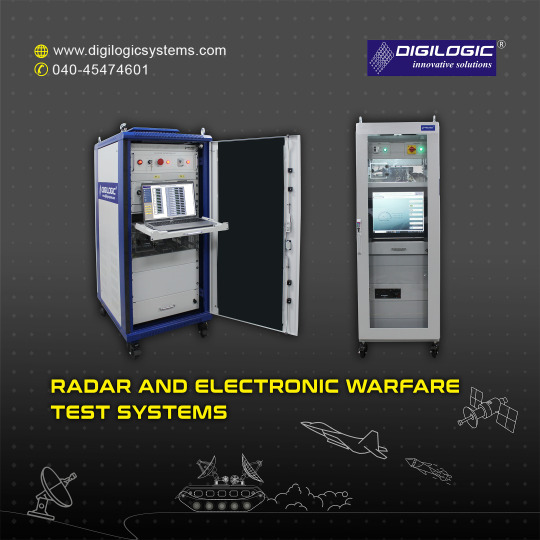
Digilogic Systems specializes in delivering next-generation Radar and Electronic Warfare Test Solutions, ranging from Radar Target Echo Simulation to IF Record & Replay Systems. Our advanced platforms are engineered to precisely test and validate mission-critical systems, ensuring they perform with optimal functionality and reliability under extreme and demanding battlefield scenarios. Our Radar test systems include: * Radar Target Echo Simulator * RCS (Radar Cross Section) Acquisition & Analysis Suite * SAR Environment Simulator * Radar Waveform Generator * Data Acquisition System * Hardware-in-the-Loop Simulation * Rugged PXIe System Our Electronic Warfare capabilities cover: * Spectrum Monitoring * FDM Demultiplexer * Blind Demodulator * IF Record & Replay System * TDOA Processor * Multi-Emitter Scenario Generator * DSSS-CDMA Radio Explore how our advanced technologies can enhance the development and validation of your mission-critical systems. 🔗 Products: https://lnkd.in/gJycadXj For enquiries, reach out to us at: 📍 Hyderabad: (+91) 40 4547 4601 📍 Bengaluru: (+91) 80 4975 6034 🌐 Website: www.digilogicsystems.com ✉️ Email: [email protected]
#RadarSimulation#RadarTesting#ElectronicWarfare#EWTestSolutions#DefenseTechnology#Aerospace#DigilogicSystems
0 notes
Text
#Safran#M88TREX#RafaleF5#aircraftengines#SafranAircraftEngines#jetengine#militaryaviation#aviationtechnology#aerospaceengineering#defensetechnology#militaryengines#defense#avgeek#aerospace#aviation#mro#MROBT#MROBTnews
0 notes
Text
#SyntheticApertureRadar#SAR#MarketGrowth#DefenseTechnology#ClimateMonitoring#CommercialApplications#InnovationInImaging#powrelectronics#powermanagement#powersemiconductor
0 notes
Text
#Aerospace#DefenseTechnology#SpecialMissionAircraft#Surveillance#AviationMarket#ElectronicWarfare#DefenseSpending#Timestech#MilitaryInnovation#AvionicsIntegration#electronicsnews#technologynews
0 notes
Text
The Submarine Battery Market is Anticipated to Witness Steady Growth Owing to Increasing Demand for Underwater Operations
The submarine battery market is a niche but critical component of submarine construction and operations. Submarine batteries provide vital backup power to critical systems in case of emergencies and are essential for underwater operations that require prolonged submergence for surveillance, patrol or attacks. Advantages of submarine batteries include their ability to provide silent, emission-free power even while submerged. They are used across military and commercial applications like naval vessels, research submersibles and energy storage
Get More Insights on Submarine Battery Market https://www.patreon.com/posts/submarine-market-129020425
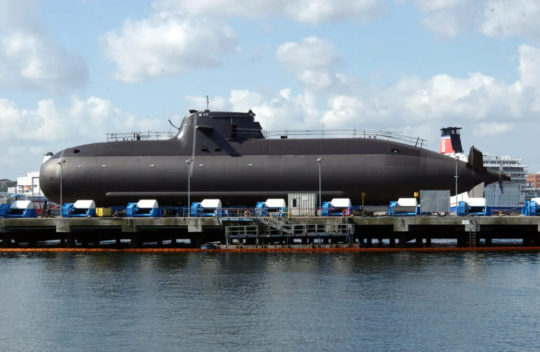
#SubmarineBatteryMarket#DefenseTechnology#NavalDefenseSystems#BatteryTechnologyAdvancements#CoherentMarketInsights
0 notes
Text
Airborne Optronics Market Fueled by Technological Innovation in Electro Optical and Infrared Sensors
The airborne optronics market is gaining significant traction across the global aerospace and defense sectors. Optronics, a combination of optics and electronics, plays a critical role in enhancing the operational capabilities of airborne platforms, such as military aircraft, unmanned aerial vehicles (UAVs), helicopters, and commercial jets. The increasing demand for advanced surveillance, navigation, targeting, and communication systems is a primary driver behind the market's expansion.

Airborne optronics systems consist of various subsystems, including electro-optical/infrared (EO/IR) sensors, laser rangefinders, targeting pods, helmet-mounted displays, and night vision systems. These technologies enable real-time situational awareness, precise target detection, and improved mission effectiveness under a wide range of environmental and operational conditions. As military operations become more dependent on precision and intelligence, the relevance of optronics continues to grow.
Key Market Drivers
One of the primary drivers of the airborne optronics market is the growing need for enhanced surveillance and reconnaissance. Modern warfare requires constant real-time intelligence, and EO/IR systems installed on aircraft are vital for this purpose. These systems provide high-resolution imagery, target tracking, and object identification, which are crucial for both combat and humanitarian missions.
Another major driver is the increasing focus on modernizing existing military aircraft fleets. Countries around the world are investing in upgrading older platforms with newer optronic systems to extend their operational lifespans and improve capabilities. For instance, retrofitting fighter jets and helicopters with new targeting pods or helmet-mounted cueing systems can significantly enhance mission performance.
In addition, the global rise in defense spending is accelerating investments in airborne optronics. As nations strengthen their air forces, there is a concurrent increase in the procurement of advanced optronic solutions that improve aircraft survivability and lethality. Emerging technologies like AI-enabled imaging and multispectral sensors are being incorporated into next-generation platforms, further pushing market growth.
Civil Aviation Applications
While defense remains the dominant segment, the adoption of optronics in civil aviation is also expanding. Commercial aircraft now incorporate vision-based systems for enhanced navigation, especially in low-visibility conditions. Enhanced Flight Vision Systems (EFVS), which use infrared cameras to improve runway visibility during takeoff and landing, are becoming more common in business and commercial aviation.
Furthermore, airborne optronics are being employed in environmental monitoring, border security, and search and rescue missions. Surveillance aircraft equipped with optronic sensors can detect forest fires, monitor coastal activities, and assist during disaster relief efforts by providing detailed imagery and terrain analysis.
Regional Insights
Geographically, North America dominates the airborne optronics market due to its robust aerospace and defense infrastructure. The presence of leading manufacturers, such as Raytheon Technologies, Northrop Grumman, and Lockheed Martin, coupled with high defense budgets, ensures sustained demand for advanced optronic systems.
Europe follows closely, driven by multinational defense projects and strong investment in both military and civilian aviation. The European Union and NATO member countries are modernizing their air fleets, fueling demand for high-end EO/IR systems.
Asia-Pacific is expected to witness the highest growth rate in the coming years. Rapidly increasing defense budgets, geopolitical tensions, and a growing emphasis on indigenous defense manufacturing in countries like China, India, and South Korea are major contributors. These nations are investing heavily in upgrading their airborne capabilities with advanced targeting and surveillance technologies.
Challenges and Opportunities
Despite strong growth prospects, the market faces challenges such as high development costs, complex integration requirements, and strict regulatory standards. Developing optronics that can operate reliably under extreme temperatures, vibrations, and electromagnetic interference adds to the cost and complexity.
However, advancements in sensor miniaturization, software-defined imaging systems, and AI integration present significant opportunities. Future trends include the adoption of AI for target recognition, data fusion for multisensor platforms, and the development of modular systems that can be easily integrated into multiple aircraft types.
Outlook
The airborne optronics market is poised for sustained growth, driven by increasing demand across both military and civilian sectors. With continued innovation and strategic investments, airborne optronics are set to become even more integral to aviation systems worldwide, enhancing mission capability, safety, and operational efficiency.
0 notes
Text
Turkey, India, and Brazil: The New Frontiers for Military Robot Market Players
Market Growth and Emerging Demand Hubs
The Military Robot market, valued at $23.9 billion in 2024, is witnessing rapid growth in emerging markets, particularly in Turkey, India, and Brazil. These countries are expected to experience a compound annual growth rate (CAGR) ranging from 5.1% to 7.6% during the period from 2025 to 2030, making them the fastest-growing demand hubs within the sector.
Key Applications Driving Market Growth
1. Intelligence, Surveillance, and Reconnaissance (ISR)
Military robots, especially unmanned aerial vehicles (UAVs) and unmanned ground vehicles (UGVs), are increasingly being deployed for intelligence, surveillance, and reconnaissance missions. The demand for ISR capabilities is fueling the growth of military robots in various defense applications.
Check detailed insights here - https://datastringconsulting.com/industry-analysis/military-robot-market-research-report
2. Bomb Disposal
The bomb disposal application has gained significant attention due to its potential to mitigate human risk. Robots like Talon and PackBot, developed by QinetiQ and iRobot, are commonly used for this purpose. These robots are equipped with advanced capabilities, such as remote control, cameras, and specialized tools, to disarm explosives safely and efficiently.
Competitive Landscape and Industry Leadership
The Military Robot market is highly competitive, with a number of leading players at the forefront of innovation and market expansion. Key industry players include:
Lockheed Martin
Northrop Grumman
Thales Group
Boston Dynamics
Aerovironment Inc.
General Dynamics Corporation
BAE Systems
Elbit Systems Ltd
Israel Aerospace Industries Ltd
Qinetiq
Turkish Aerospace Industries
Leonardo SPA
These companies are investing heavily in autonomous systems and forming strategic partnerships to capture larger market share and enhance operational capabilities.
Adoption of Autonomous Systems in Military Robotics
The military robot industry is undergoing a significant transition towards autonomous systems, which are revolutionizing the operational efficiency of defense units globally. This shift is largely driven by advancements in AI technologies and machine learning (ML) algorithms, enabling robots to conduct complex tasks with minimal human intervention.
The integration of autonomous systems is particularly evident in unmanned aerial vehicles (UAVs), which are optimizing various defense processes, such as reconnaissance missions and tactical strikes. This trend is expected to have a profound impact on the technology and automation sectors, with rising demand for sophisticated robotics solutions.
Global and Regional Market Analysis
Global Market Forecast
The Military Robot market is projected to grow from $23.9 billion in 2024 to $55.2 billion by 2035, reflecting a CAGR of 7.9%. The market is being driven by increasing defense budgets, rising demand for autonomous defense systems, and technological advancements in robotics and AI.
Regional Dominance and Trends
North America currently dominates the global Military Robot market, particularly in the United States, which leads in R&D investments and the development of cutting-edge unmanned combat vehicles. The U.S. government’s emphasis on advanced military equipment and automation has positioned it as a leader in the global defense robotics space.
Despite North America's dominance, the Asia-Pacific region, especially Turkey, India, and Brazil, is rapidly emerging as a significant growth hub for military robotics. These regions are increasing their investments in defense automation and military technologies to enhance their defense capabilities.
Key Market Drivers and Challenges
Market Drivers:
Minimization of Soldier Casualties: The development and deployment of military robots are focused on reducing human exposure to dangerous tasks, such as bomb disposal and combat operations.
Efficiency in Dangerous Tasks: Robots can perform hazardous tasks, such as explosive ordnance disposal and reconnaissance, more effectively and safely than humans.
Advancements in Autonomous Technology: The shift towards autonomous systems is enabling military robots to perform more complex tasks with minimal human oversight.
Challenges:
Regulatory Frameworks: One of the challenges to growth in military robotics is the underdeveloped regulatory frameworks for robotic operations in defense settings, especially in emerging markets.
Research Scope and Segmentation
The Military Robot market can be analyzed across several key segments:
Platform:
Land
Air
Sea
Amphibious
Application:
Combat Operations
Surveillance & Reconnaissance
Logistics & Supply Delivery
Search & Rescue
Explosive Ordnance Disposal
Training & Simulation
Mine Clearance
Payload Type:
Sensors
Weapons
Cameras
Communication Systems
Explosive Detectors
Mode of Operation:
Autonomous
Tethered
Tele-operated
Technology:
Autonomous
Semi-Autonomous
Key Growth Opportunities
Exploring Emerging Markets: Turkey, India, and Brazil present significant opportunities for military robot manufacturers to tap into new demand hubs, fueled by defense modernization and the increasing adoption of autonomous technologies.
Technological Advancements: Innovations in AI, machine learning, and robotics are driving the next generation of military robots, enabling new applications and capabilities in defense operations.
Strategic Partnerships: Collaborations between defense contractors and governments can open up new opportunities for military robot manufacturers to expand their reach and market share.
About DataString Consulting
DataString Consulting is a leading market research and business intelligence firm that assists companies in developing strategic roadmaps, expanding into new markets, and formulating revenue diversification strategies. Our expertise includes providing in-depth insights into emerging trends, competitor landscapes, and customer demographics.
With over 30 years of combined experience, DataString Consulting offers tailored solutions to help businesses identify new opportunities and improve market positioning. We specialize in strategy consulting, opportunity assessment, and solution-oriented approaches to solve complex business challenges.
#MilitaryRobots#DefenseTechnology#AutonomousSystems#AIinDefense#MilitaryTechnology#UnmannedAerialVehicles#ISR#BattlefieldManagement#DefenseModernization#RoboticsInMilitary#CounterTerrorism#AIandRobotics#UnmannedVehicles#GlobalDefenseMarket#MilitaryRoboticsInnovation#TechnologyTrends#StrategicPartnerships#GlobalSecurity#TacticalRobotics#MilitaryAutomation#FutureOfWarfare#DefenseIndustryGrowth#EmergingMarkets#SupplyChainInnovation#AIinMilitaryApplications
0 notes
Text
GPS Spoofing Incident: IAF’s Aircraft Misled Near Myanmar
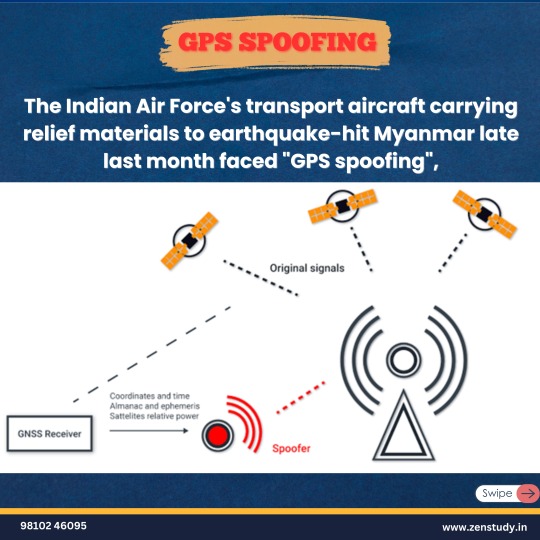
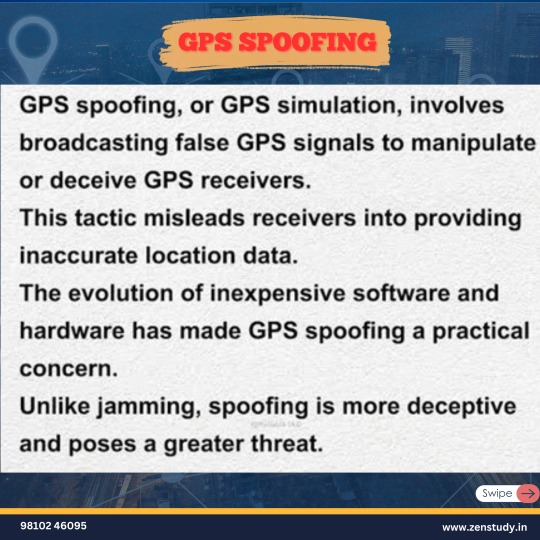

In a recent event highlighting cyber vulnerabilities, the Indian Air Force's aircraft carrying earthquake relief to Myanmar was hit by a “GPS spoofing” attack. This technique manipulates GPS signals to mislead the aircraft's navigation systems. The incident raises serious national security concerns and calls for stronger cyber-defense mechanisms in aviation. For UPSC aspirants, topics like cybersecurity, space technology, and international relations become relevant in both GS Paper 3 and Current Affairs. Stay updated with ZenStudy to decode such crucial topics with UPSC relevance and real-time awareness.
🌐 Website: https://zenstudy.in/
📲 Telegram: https://t.me/Zenstudyltd
📘 Facebook: https://www.facebook.com/profile.php?id=61555473406607
📸 Instagram: https://www.instagram.com/zenstudyz/
▶️ YouTube: https://www.youtube.com/@Zenstudyz
#upscfoundationbatch#GPSSpoofing#IndianAirForce#CyberSecurity#DigitalThreats#IAF#UPSC2025#UPSCPrelims2025#UPSCMains2025#UPSCRelevantTopics#CyberWarfare#UPSCGS3#InternationalRelationsUPSC#SpaceTechnologyUPSC#GS3CyberSecurity#IAFNews#MyanmarReliefMission#CyberAttack#SpoofingExplained#ZenStudy#CurrentAffairsUPSC#UPSCUpdates#IASPreparation#IndiaMyanmarRelations#UPSCNotes#UPSCFactPost#DailyUPSCPost#AirSecurity#GeopoliticsUPSC#DefenseTechnology
0 notes
Text
Airborne Fire Control Radar Market Future Trends Highlighting Technological Progress and Strategic Defense Shifts
The airborne fire control radar market is experiencing a transformative phase driven by evolving combat requirements, rising defense budgets, and increasing geopolitical tensions. Governments and military organizations worldwide are investing heavily in modernizing their airborne systems, leading to a surge in the adoption of advanced radar technologies. These systems are no longer viewed as optional components but as essential assets for ensuring mission success in both defensive and offensive operations.
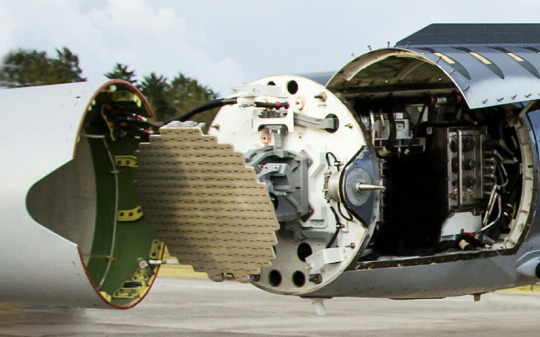
One of the most defining future trends in this market is the integration of artificial intelligence (AI) and machine learning (ML) into radar systems. These technologies significantly improve the radar’s ability to process complex data in real-time, enabling faster target detection, identification, and tracking. AI-powered fire control radars can automatically prioritize threats, manage multiple targets simultaneously, and reduce operator workload, which is especially critical in high-intensity conflict environments.
Additionally, the transition towards active electronically scanned array (AESA) radar systems is becoming more prominent. AESA radars offer numerous advantages over traditional mechanically scanned systems, such as enhanced resolution, faster beam steering, and improved resistance to electronic jamming. These capabilities are vital for modern fighter aircraft and unmanned aerial vehicles (UAVs) that operate in electronically contested environments. Countries like the U.S., China, India, and Russia are actively upgrading their aerial fleets with AESA-enabled radars, setting a clear direction for the market’s future.
Another important trend is the miniaturization of radar systems without compromising performance. As UAVs and smaller aircraft become more integral to military operations, there is a growing need for compact, lightweight radars that can deliver the same level of accuracy and functionality as those used in larger aircraft. Companies are investing in R&D to develop scalable radar solutions that can be customized for different platforms. This flexibility is expanding the market’s reach and diversifying its applications.
The market is also witnessing the growing use of multifunction radar systems. These systems combine surveillance, tracking, and fire control functionalities into a single platform, optimizing cost and weight while enhancing operational efficiency. Multifunction radars are particularly beneficial in multi-role aircraft, where space and weight limitations are crucial factors. This shift towards consolidation is a response to the increasing complexity of aerial warfare, where aircraft must perform various tasks simultaneously.
Global defense strategies are also influencing the market’s trajectory. With the increasing emphasis on joint and network-centric warfare, fire control radars are now being developed with enhanced interoperability. Modern systems are designed to share data across platforms—manned and unmanned, air and ground—creating a cohesive situational awareness environment. This capability ensures that real-time target information is accessible across the defense ecosystem, leading to better-coordinated attacks and efficient resource deployment.
Furthermore, regional tensions and modernization programs are propelling demand in emerging markets. For instance, countries in Asia-Pacific and the Middle East are rapidly enhancing their defense capabilities, leading to increased procurement of next-gen aircraft equipped with sophisticated radar systems. These nations are not only buyers but are also increasingly becoming developers, engaging in collaborations and joint ventures to create indigenous radar technologies.
Environmental adaptability is another area seeing innovation. Modern airborne fire control radars are now being designed to function effectively across a variety of operational environments—from high-altitude arctic zones to low-visibility desert conditions. Enhanced signal processing and robust material design ensure that these systems remain reliable despite harsh external factors, a necessity given the global nature of modern military operations.
Cybersecurity concerns are also shaping future radar technologies. With the rising risk of cyberattacks on military assets, radar systems are being equipped with cybersecurity features to protect sensitive data and maintain operational integrity. Secure software frameworks and encrypted data links are being incorporated to mitigate the risk of unauthorized access or manipulation.
Looking ahead, the airborne fire control radar market is poised for robust growth driven by these technological advancements and strategic imperatives. The next generation of radar systems will not only enhance combat capabilities but also enable smarter, faster, and more agile decision-making in complex battle scenarios. As nations continue to prioritize air superiority and defense modernization, the demand for sophisticated airborne fire control radar systems will remain strong, ensuring a dynamic and competitive market landscape for years to come.
0 notes
Text
কৃত্রিম বুদ্ধিমত্তা এবং অন্যান্য উদীয়মান প্রযুক্তি যুদ্ধক্ষেত্রে বিপ্লব ঘটাচ্ছে,রাজনাথ সিং

https://durantbarta.com/country/artificial-intelligence-and-other-emerging-technologies-are-revolutionizing-the-battlefield-says-rajnath-singh
#RajnathSingh#ArtificialIntelligence#EmergingTechnologies#AIInDefense#RevolutionizingTheBattlefield#AIInWarfare#DefenseTechnology#ModernWarfare#IndianDefense#RajnathSinghSpeech#TechnologyInDefense#AIInMilitary#FutureOfWarfare#RajnathSingh2025#NationalSecurity#DefenseInnovation#IndiaDefense#MilitaryTech#durantabarta
0 notes